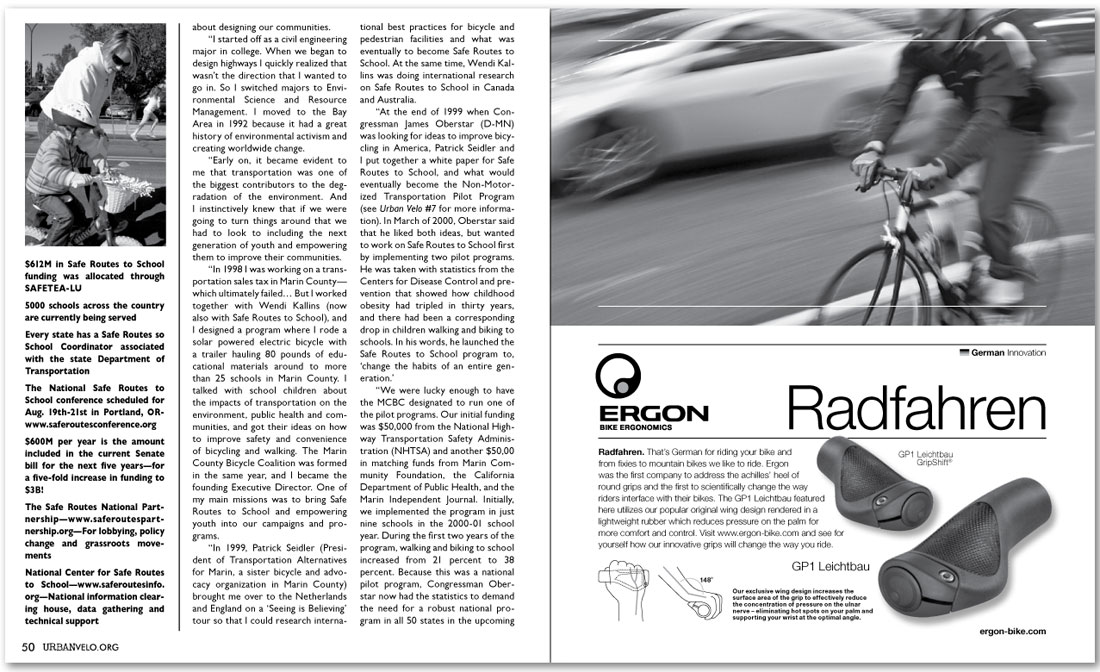|
about designing our communities.
“I started off as a civil engineering major in college. When we began to design highways I quickly realized that wasn’t the direction that I wanted to go in. So I switched majors to Environmental Science and Resource Management. I moved to the Bay Area in 1992 because it had a great history of environmental activism and creating worldwide change.
“Early on, it became evident to me that transportation was one of the biggest contributors to the degradation of the environment. And I instinctively knew that if we were going to turn things around that we had to look to including the next generation of youth and empowering them to improve their communities.
“In 1998 I was working on a transportation sales tax in Marin County— which ultimately failed… But I worked together with Wendi Kallins (now also with Safe Routes to School), and I designed a program where I rode a solar powered electric bicycle with a trailer hauling 80 pounds of educational materials around to more than 25 schools in Marin County. I talked with school children about the impacts of transportation on the environment, public health and communities, and got their ideas on how to improve safety and convenience of bicycling and walking. The Marin County Bicycle Coalition was formed in the same year, and I became the founding Executive Director. One of my main missions was to bring Safe Routes to School and empowering youth into our campaigns and programs.
“In 1999, Patrick Seidler (President of Transportation Alternatives for Marin, a sister bicycle and advocacy organization in Marin County) brought me over to the Netherlands and England on a ‘Seeing is Believing’ tour so that I could research international best practices for bicycle and pedestrian facilities and what was eventually to become Safe Routes to School. At the same time, Wendi Kallins was doing international research on Safe Routes to School in Canada and Australia.
“At the end of 1999 when Congressman James Oberstar (D-MN) was looking for ideas to improve bicycling in America, Patrick Seidler and I put together a white paper for Safe Routes to School, and what would eventually become the Non-Motorized Transportation Pilot Program (see Urban Velo #7 for more information). In March of 2000, Oberstar said that he liked both ideas, but wanted to work on Safe Routes to School first by implementing two pilot programs. He was taken with statistics from the Centers for Disease Control and prevention that showed how childhood obesity had tripled in thirty years, and there had been a corresponding drop in children walking and biking to schools. In his words, he launched the Safe Routes to School program to, ‘change the habits of an entire generation.’
“We were lucky enough to have the MCBC designated to run one of the pilot programs. Our initial funding was $50,000 from the National Highway Transportation Safety Administration (NHTSA) and another $50,00 in matching funds from Marin Community Foundation, the California Department of Public Health, and the Marin Independent Journal. Initially, we implemented the program in just nine schools in the 2000-01 school year. During the first two years of the program, walking and biking to school increased from 21 percent to 38 percent. Because this was a national pilot program, Congressman Oberstar now had the statistics to demand the need for a robust national program in all 50 states in the upcoming
continued |
|
$612M in Safe Routes to School funding was allocated through SAFETEA-LU
5000 schools across the country are currently being served
Every state has a Safe Routes so School Coordinator associated with the state Department of Transportation
The National Safe Routes to School conference scheduled for Aug. 19th-21st in Portland, OR—www.saferoutesconference.org
$600M per year is the amount included in the current Senate bill for the next five years—for a five-fold increase in funding to $3B!
The Safe Routes National Partnership—www.saferoutespartnership.org—For lobbying, policy change and grassroots movements
National Center for Safe Routes to School—www.saferoutesinfo.org—National information clearing house, data gathering and technical support |
|

